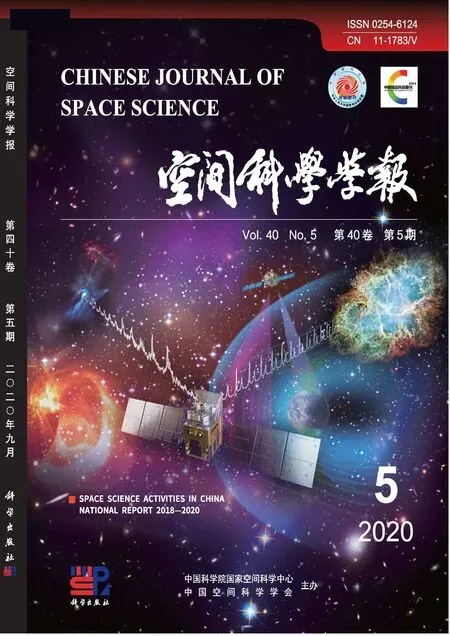Taiji-1 Satellite Mission*
LUO Ziren ZHANG Min WU Yueliang
Taiji-1 Satellite Mission*
LUO Ziren1,2ZHANG Min1,3WU Yueliang1,3
1 (100049) 2 (100190) 3 (100190)
China’s first satellite to conduct experiments on key technologies related to space-based grav-itational wave detection, Taiji-1, has successfully completed its in-orbit tests, making a breakthrough in the country’s gravitational wave detection. With the success of Taiji-1’s in-orbit tests, the first goal of Chinese Academy of Science’s three-step strategy to implement the Taiji program has been successfully achieved.
Gravitational wave, Taiji program, Drag-free control system
Taiji-1 was launched on 31 August 2019, and it was China’s first satellite to conduct in-orbit experiments on the key technologies related to space-borne Gra-vitational Wave (GW) detection. It’s also the first step of Taiji program, which is a Chinese space-borne GW detection mission leading by Chinese Academy of Sciences[1,2]. Unlike the ground-based GW observatory LIGO[3], Taiji is focused on GWs at lower frequencies to observe celestial bodies with greater mass or located farther away in the universe[4]. However, the gravitational wave signals from those sources are extremely weak, posing great challenges for detection. To ensure a successful mission performance for Taiji, it was set a 3-step plan to launch Taiji in early 2030s (see Figure 1).
The first step of Taiji program is to continue technology development in addition to the launch of a pilot study satellite called Taiji-1 (a glance at the Taiji-1 satellite please see Figure 2). The second step is to launch Taiji pathfinder (also called Taiji-2). Taiji-2, consisting of two satellites, is to demonstrate most of Taiji technology and to pave the way for Taiji.
Taiji-1 was approved on 30 August 2018, a year before its launching. The orbit of Taiji-1 was a circular Sun-synchronous orbit inclined 97.79°. The altitude of Taiji-1 orbit is 600 km. The two major technology units, optical metrology system[5]and drag-free control system[6], were tested on Taiji-1. The optical metrology system consisted of an optical bench, phasemeter, and two laser sources. While the drag- free control system is composed of a gravitational reference sensor, a drag-free controller, and two types of μN-thrusters.

Fig. 1 3-step plan of Taiji program

Fig.2 Design picture (a) and photo (b) of Taiji-1
Taiji-1 now has completed its designed tasks, and all the payloads were successfully tested. The accuracy of displacement measurement of the laser interferometer on Taiji-1 reached 100 pm·Hz–1/2, equi-valent to the size of an atom. The accuracy of the gra-vitational reference sensor on the satellite reached 10–9ms–2·Hz–1/2, ten billionths of the magnitude of the Earth’s gravitational acceleration. The resolution of the micro-thruster on the satellite reached 0.1 μN·Hz–1/2order of magnitude. The residue acceleration of the sa-tellite after drag-free control was below 10–7ms–2·Hz–1/2.
The successful flight of Taiji-1 has verified the feasibility of Taiji’s 3-step plan, and laid a solid foundation for future gravitational wave observation in space for China.
[1] LUO Z R, GUO Z K, JIN G,. A brief analysis to Taiji: science and technology [J]., 2020, 16:102918
[2] LUO Z R, JIN G, WU Y L,. The Taiji program: a concise overview [J]., 2020. DOI: 10.1093/ptep/ptaa083
[3] LIGO Scientific Collaboration. Advanced LIGO [J]., 2015, 32:074001
[4] GONG Xuefei, XU Shengnian, YUAN Yefei,. Laser interferometric gravitational wave detection in space and structure formation in the early universe [J].., 2015, 39(4):411-446
[5] HEATHER E A. LISA Path?nder: optical metrology sys-tem monitoring during operations [J].., 2017, 840:012034
[6] FICHTER W, GATH P, VITALE S,. LISA pathfinder drag-free control and system implications [J]., 2005, 22(10):S139-S148
V 474
LUO Ziren, ZHANG Min, WU Yueliang. Taiji-1 Satellite Mission., 2020, 40(5): 691-692. DOI:10.11728/ cjss2020.05.691
* Supported by Strategic Priority Research Program of the Chinese Academy of Science (XDA15020709)
July 28, 2020
E-mail: zhang-min@ucas.ac.cn

